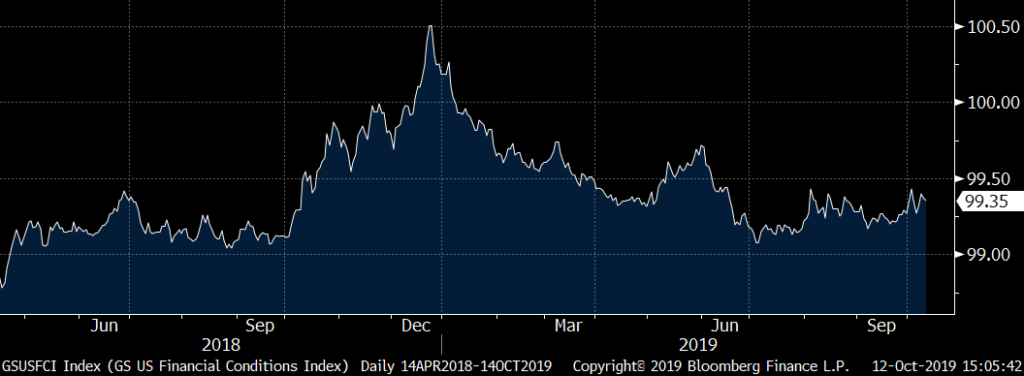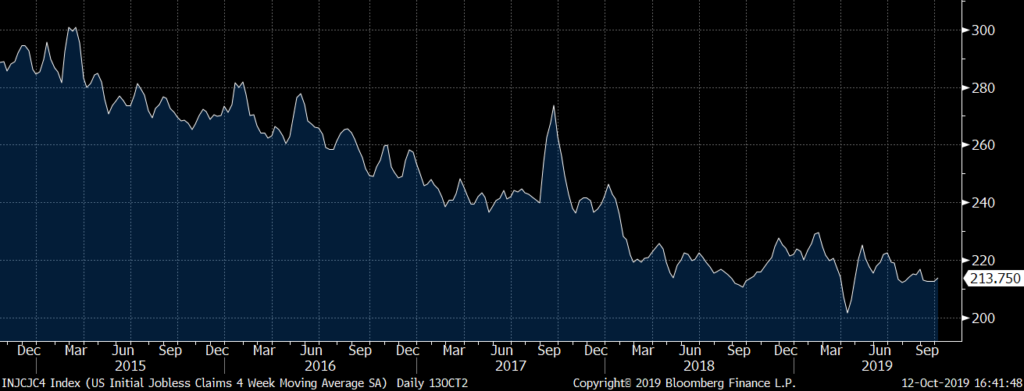by Paul Broughton
It’s mid-October which means fall football, playoff baseball, and beautiful fall scenery. This fall, however, financial markets still seem to be experiencing above average amounts of uncertainty due to ongoing trade disputes and concerns over slowing economic growth. And, quietly and somewhat reluctantly, the Federal Reserve Bank has increased its monetary accommodation and taken steps to improve liquidity by increasing bank reserves. Could the worries which derailed markets in the fall of 2018 reappear this year? We don’t think so.
Indeed, the Federal Reserve Bank seems to be taking steps to quell the aforementioned heightened uncertainty as evidenced in its recently released September FOMC minutes. In its outlook discussion, it mentioned risks to economic growth due to trade policy uncertainty 16 times. Economic growth of 2.9% in 2018 has slowed to a forecast of 1.7% for 3Q 2019, according to the Atlanta Fed. This slower growth has induced the Fed to cut rates twice, in July and September, and it looks poised to cut again in late October. The current effective Fed Funds rate stands at 1.80% and that 1.80% is greater than the 10-year Treasury yield of 1.73%. This yield curve inversion and the absolute low level of the 10-year yield is potentially indicative of a slowing economy. Hence, the Fed is in easing mode, even though it’s reluctant to call it an easing cycle due to an economy operating at close to full employment and inflation just below its targeted level of 2%.
And to avoid another sudden increase in repo rates, as seen in mid-September, the Fed this past week announced that it will be buying $60 billion of U.S. Treasury Bills on a monthly basis through at least the second quarter of next year in order to increase the level of bank reserves. Fed Chair Powell was very clear that this wasn’t another round of quantitative easing, rather this step is simply to add reserves to the banking system after almost two years of letting its bond portfolio runoff. This should help avoid a repeat of the fourth quarter of last year when the S&P 500 fell by over 13%. At that time, financial conditions tightened when investors feared that sharply higher interest rates were on the horizon, as seen in the GS Financial Conditions Index, below. Those fears were triggered by Powell’s offhand remark that we were still a “long way from neutral” on the Fed Funds rate. Compounding the resulting shortage of liquidity, the largest banks at the time needed to reduce the asset side of their balance sheets to comply with year-end capital requirements. Given the Fed’s current stance and efforts to boost liquidity, we would not expect a repeat of last fall’s selloff.
GS US Financial Conditions Index

Source: Goldman Sachs Financial Conditions Index, Bloomberg, LLC.
And perhaps more importantly, as we approach year-end 2019, there are some reasons for optimism despite the concerns over slowing economic growth and how late we are in the economic cycle. Weekly jobless claims remain very low and consumer confidence remains very healthy (remember that consumer spending comprises about 68% of GDP). Unemployment is at a 50-year low.
Jobless Claims 4 Week Moving Average

Source: Bloomberg, LLC.
Consumer Confidence Index

Source: Bloomberg, LLC.
The Fed is in easing mode. And there’s been some progress made in deescalating the trade conflict with China. Corporate earnings, for S&P 500 companies, are expected to return to double-digit growth next year. The S&P 500 is up by about 20% so far this year and up 8% over the past twelve months. Despite all of the trade war issues and concerns over a slowdown, these modest underlying sources of strength are helping the market continue to climb the proverbial wall-of-worry.
ACM is a registered investment advisory firm with the United States Securities and Exchange Commission (SEC). Registration does not imply a certain level of skill or training. All written content on this site is for information purposes only. Opinions expressed herein are solely those of ACM, unless otherwise specifically cited. Material presented is believed to be from reliable sources and no representations are made by our firm as to another parties’ informational accuracy or completeness. All information or ideas provided should be discussed in detail with an advisor, accountant or legal counsel prior to implementation. All investing involves risk, including the potential for loss of principal. There is no guarantee that any investment plan or strategy will be successful. ©ACM Wealth

